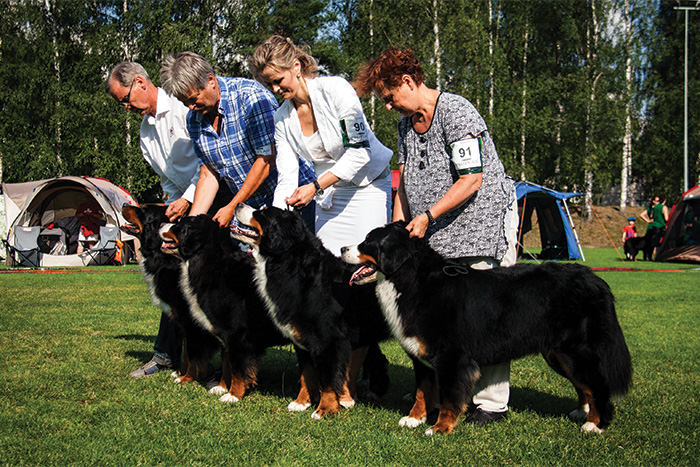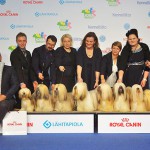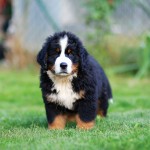Kronblommas Bernese Mountain Dogs
Interview with Mr. Björn Magnusson • Interviewed by Tatjana Bilbija-Lalicevic
Published in Best in Show Summer 2015
BIS: When and how did you get involved in dogs? Why did you choose to breed Bernese dogs?
B.M.: In 1982 I saw my first Bernese Mountain Dog, and was completely charmed by its beauty when it came to color and form; the contrasts between black and white and the wonderful tan colouring. I could not resist the friendly loving expression. In 1984 I bought my first Bernese Mountain Dog, and I was hooked, I had found my breed. Earlier, I had had German Shepherd, Dalmatian and Golden Retriever. It was purely coincidental that I became a breeder. At a dog show, I watched a woman who started running her dog before going into the ring. I admired her beautiful dog and enjoyed watching it move. That woman was Gunilla Odenfelt from Odenhills kennel. I got the courage to ask her if it was possible to buy a female puppy from her next litter. She told me she was expecting puppies in the next few weeks and that I would be able to get a female. Unfortunately, there was only one bitch in that litter, so instead I got a bitch – Odenhills Amina – on breeding terms. Amina had nine puppies and there I got my foundation bitch, Odenhills Eya.
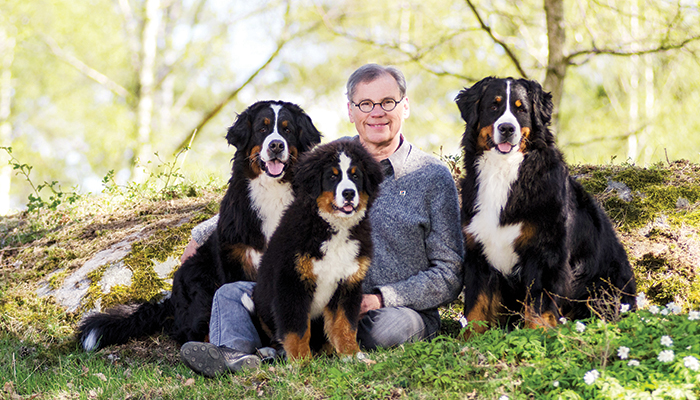
BIS: Is there a dog you consider the foundation of your own breeding program?
B.M.: Kronblommas Cherubino (Kronblommas Aithra x Macis Zam Mont Morzy) & Kronblommas Isolde (Kronblommas Cherubino x Zanzebern Defender)
BIS: How many dogs do you have at home (living with you) and how many you co-own?
B.M.: Presently I have thirteen dogs. When your breeding is successful, the family grows quickly. To say how many dogs one should have is difficult; if you are lucky in breeding, you could manage with only a few. In our breed, which unfortunately suffers from many diseases, it is difficult to have only a few breeding females. The gene pool benefits if one has multiple females, from different bloodlines, it secures the future.
BIS: Do you prefer line breeding or outcross? How do you chose your combination?
B.M.: I have only experienced outcross, but am not opposed to using line breeding within reason. I have the privilege to be able to travel with my partner, Svante Frisk, an International FCI judge, to visit dog shows. I choose the type first, and then I look at the individual’s pedigree and the possible diseases that may be there. I must have the right feeling for the dog I use. Type is the first attribute I look at, then the chest shape, length and depth is secondary. The chest is so important because it is the body that supports and gives the strength for proper movement. Lack of substance is inconceivable to me.
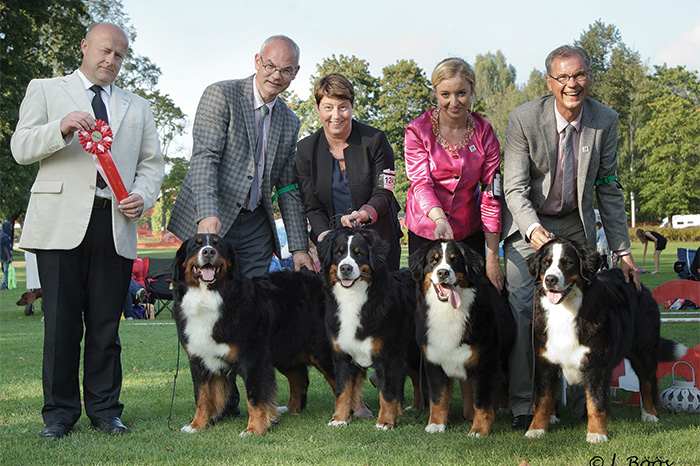
BIS: With which kennels do you collaborate on breeding? How important was cooperation between breeders through time?
B.M.: In Sweden we have succeeded in working towards a common goal in terms of the various diseases of the breed. I would also like to develop more cooperation in terms of type and anatomy. I have had the privilege to work with prominent kennels abroad – Van’t Rijkenspark in the Netherlands, Stokerybos in Belgium and Starry Town in Italy – which have been very inspiring and educational for me.
BIS: Did you have a mentor when you got started?
B.M.: As I worked with Gunilla, she shared her knowledge and experience with me. She assisted me on breeding trips and taught me much of what I know today. She’s been an invaluable mentor and source of inspiration. Still today, before breeding, I ask myself, “What would Gunilla do?” She has taught me the importance of being honest with colleagues and myself.
BIS: Tell us please the main characteristics you admire in the breed?
B.M.: The colours, the markings, and their friendly loving expression. The Bernese Mountain Dog is a sturdy and adaptable working dog with strong limbs, but still a good clean head with moderate stop and dry lips. It is a harmonious and well-balanced dog with a long, shiny coat and brown, almond-shaped eyes that say: “I’m a good dog that loves to be cuddled”.
BIS: Do the Bernese change over the time since you first got involved with the breed?
B.M.: I think they have changed for the better, specifically in terms of structure and movement. I see that in some countries the legs have become too short and the dog too long.
A Bernese Mountain Dog should be 9:10. In some countries, the heads become like a Molosser, while a beautiful Bernese Mountain Dog should have a clean, dry head. Chests have become too narrow. Over-angled dogs are more common today.
BIS: What do you consider your greatest achievement in breeding and in showing dogs?
B.M.: As a breeder, I am happy for the individual victories and naturally the champion titels.
But to win a breeder’s group, is something I’m particularly proud of and enjoy. Therefore, I’d have to choose the special exhibition in Finland, the day before the World Expo 2014; there were 11 in the class and my group was number one and best in show breeders group. In 2014, I was named # 1 BMD breeder in Sweden.
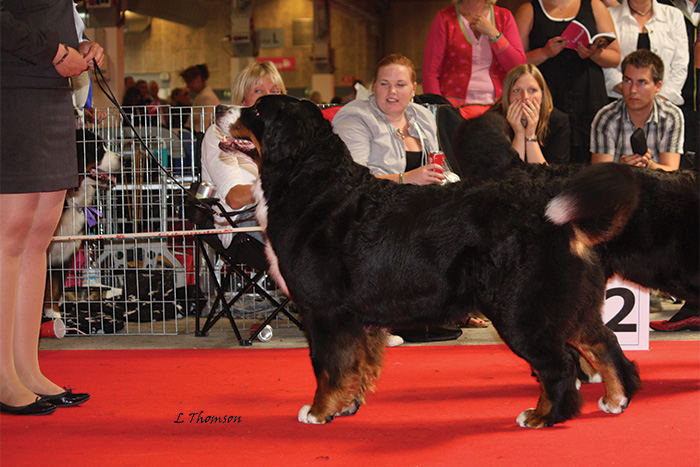
BIS: Please mention 2 or 3 Newfoundlanders/Bernese which are not owned, bred or shown by yourself, that you particularly admired, and tell us what you most admired about each.
B.M.: I have several favorites, all of which fit within the standard and all have amazing qualities: Macis Zam Mont Morzy, Gangsterluvans Keno Kanon, Bernerdalens Gina, all from Sweden; Emerson van ‘t Stokerybos and Jerome van’ t Stokerybos from Belgium; Yoyo van’t Rijkenspark from the Netherlands; Zanzebern Defender from Australia; Noble Nocturne av Milkcreek from Norway; Sennetta’s Sixten from Denmark.
BIS: Every breed has some common problems. Which is the most common problem in your breed seen from a breeder’s point of view?
B.M.: The main problems have to do with health. We have a problem with rapid aging in terms of all diseases, but also breed specific diseases such as Histiocytic Sarcoma and Malignant Histiocytosis. A group of researchers in France have found markers in sick dogs, and thus arrived at a “risk test”. Here lies a great danger! Are the breeders so knowledgeable that they will use all breeding stock or will they exclude a certain part? The future will tell, but for my part, I am positive about this and have tested all of my dogs.
BIS: What has been the biggest disappointment in breeding and showing for you so far?
B.M.: I have made some mistakes. But these mistakes have made me a better, more competent breeder and so I do not want to have them undone.
BIS: What is the most important point of which you would like a judge of your breed to be aware?
B.M.: We have a number of fantastic judges that know the breed exceptionally well.
I keep an eye on them to see whom they select and in such a way consider the males for potential breeding. There are also those judges who choose male dogs with female heads and long swan necks, with heavily angled hindquarters and chests that would fit better on a setter.
